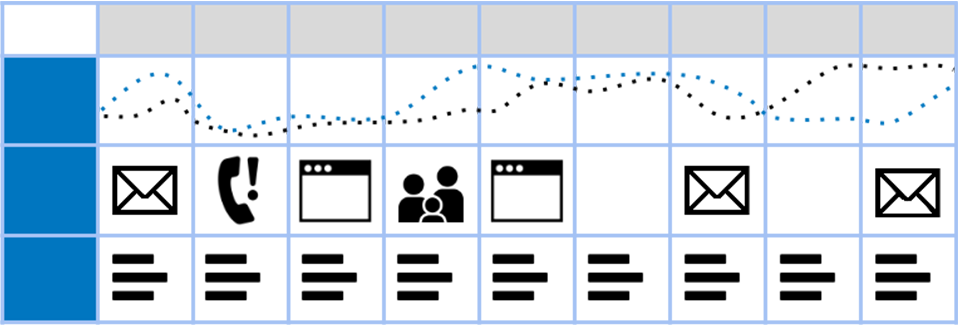
We explained in a previous post how useful it can be to make a user journey map of a service. In this post I’ll give some tips on how to create them.
What to include in user journeys maps:
The type of user journey maps we use are made up of a horizontal and a vertical axis (basically they’re a grid).
1. horizontal axis contains phases, activities, steps
Think about the time frame, think about when the user journey starts - when does the user need arise? What does a user do first? What phases does a person go through? Are there specific activities within each phase? What are their routes into a transaction? When does the journey end? Is it cyclical? Is it one time use or linear?

2. vertical axis contains any additional layers of information you need to understand about the user journey

This could include emotional levels - how a user feels as they move through the service - and research insights for different types of user, user needs and objectives, channels the service is delivered through (e.g. phone, web, mail, face-to-face), or touchpoints (ie where the user interacts with something), departments, teams and 3rd parties, supporting back end systems…
There’s three distinct phases in using user journey maps in the process of building or redesigning a service:
1. Hypothetical ‘As-is journeys’, that sketch out how a service may work now.
These are often a useful starting point for the project. They can help define the scope of research. They can help pull out assumptions from internal stakeholders about how things work (that can later be challenged through research). Though they may start out as a hypothetical exercise, they can then turn into a…
2. Research-based journey map
Ultimately, it’s important that user journey maps are based on good user research, rather than made up by stakeholders or team members. If they are, then they may just reflect the organisation’s assumptions and beliefs about users, which often doesn't match users actual experience. The research based journey map:
- gives you your starting point from which to begin your design work;
- helps you capture and synthesis the current experience of real users (this might mean changing the structure from your hypothesis);
- shows how things work (or don’t) and what the interdependencies are;
- highlights pain points and where things are broken;
- uncovers the most significant opportunities for change
The research-based journey map should be about what actually happens, not what people would like to happen. That’s a role for the third type of user journey map...
3. To-be journeys that show how we want things to be.
These can also be used as a working document or communication tool at different points in a project to help:
- you to build and develop without losing the thread, or forgetting the user’s point of view
- build a consensus about what you’re aiming for
- flag up who you should be talking to about changing other aspects of the service
- to show how stuff should work and how things will be connected
- for convincing people about things that need to be done
- for building a roadmap for delivery
Things to bear in mind
As I said in the earlier post not everything in a service can fit into a straight-up linear journey. There may be offshoots, cyclical bits or too much variance in the steps and activities from one user to the next.
And it’s not the only useful way of mapping a service. There are other ways of mapping things that might work better for what you’re trying to explore or explain, user journeys are just a way of mapping things over time.
